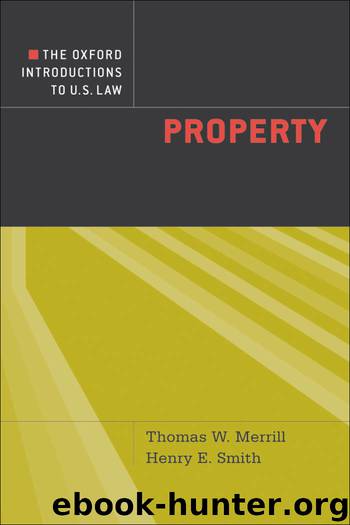Property by Merrill Thomas W.; Smith Henry E.;

Author:Merrill, Thomas W.; Smith, Henry E.;
Language: eng
Format: epub
Publisher: Oxford University Press USA - OSO
Published: 2010-05-21T04:00:00+00:00
Models of the Lease Contract
If leases were always construed like ordinary bilateral contracts for the sale of goods or services, there would be little reason to study the contractual aspect of leasing as a distinct topic. Lease law would simply be an application of ordinary contract law. Unfortunately, things are not so simple. Lease law initially developed at a time when contract law was different from what it is today. Perhaps because of heightened respect for stare decisis in matters involving property rights, courts have been slow to update the understanding of the contractual aspect of leasing law. One can distinguish three phases in the evolution of the contractual model in lease law.5
The first phase conceived of the lease as a bundle of independent covenants or promises. Take a very simple lease in which L promises to transfer possession of Blackacre to T for three years, and in return T promises to pay L $100 per year in rent. The promise to provide possession and the promise to pay rent were originally regarded as independent of each other. Thus, if a foreign invader seized Blackacre, ousting T from possession, T was still obligated to pay rent to L.6 Or, if T stopped paying rent, L was still obligated to provide T possession. The remedy for breach of any of the independent covenants, as was generally the case in actions at common law, was an award of damages. The one exception to this rule was if the landlord breached the so-called covenant of quiet enjoyment—the promise to provide possession to the tenant—by ousting the tenant during the term of the lease. Ouster by the landlord excused the tenant from further payment of rent, until the ouster was cured.
The model of independent covenants had a number of harsh consequences for both landlords and tenants. If the tenant abandoned the property and stopped paying rent, the model required the landlord to let the property stand idle while periodically suing the tenant for damages—often to no avail if the tenant was insolvent or had disappeared. Or, if the landlord breached covenants regarding the condition of the property, such as a covenant to provide heat, the tenant’s only recourse was to shiver and sue for damages.
In the second phase of the evolution of leasing law, which we can call the transitional model, courts and legislatures responded to these sorts of problems by adopting rules and doctrines designed to ameliorate the harshness of the independent covenants model, without abandoning its logic. The transitional model developed several rules that remain important today. To provide relief to the landlord faced with a defaulting and potentially insolvent tenant, courts permitted landlords to insert clauses in leases that allowed landlords to reenter and relet property upon default by the tenant. In effect, the landlord could elect to terminate the lease in the event of default. To cut off the tenant’s liability for rent when the tenant had abandoned and the landlord took steps to reenter, courts developed the surrender doctrine.
Download
This site does not store any files on its server. We only index and link to content provided by other sites. Please contact the content providers to delete copyright contents if any and email us, we'll remove relevant links or contents immediately.
The Social Psychology of Inequality by Unknown(2759)
The Plant Paradox by Dr. Steven R. Gundry M.D(2425)
The Writing on the Wall by Anselm Jappe(1969)
Working for Yourself by J.D. (Nolo) Stephen Fishman(1736)
Every Landlord's Legal Guide by Janet Portman & Stewart Marcia & Ralph Warner(1564)
The First 20 Hours: How to Learn Anything ... Fast by Kaufman Josh(1559)
ADHD on Trial by Michael Gordon(1470)
Decisive by Chip Heath(1455)
Working for Yourself by Stephen Fishman J.D. (Nolo)(1419)
Drafting Contracts: How and Why Lawyers Do What They Do, Second Edition by Stark Tina L(1402)
A Practical Guide to International Arbitration in London by Hilary Heilbron(1347)
The Economist Aug 8th 2015 by The Economist(1341)
Restitution by Restitution(1328)
The Lord of the Rings: The Fellowship of the Ring, the Two Towers, the Return of the King by J. R. R. Tolkien(1320)
Intellectual Property Strategy by John Palfrey(1317)
The Economist Aug 29th 2015 by The Economist(1300)
Collusion by Luke Harding(1243)
Persuasion by Owner(1223)
The New Whistleblower's Handbook by Stephen Kohn(1143)
